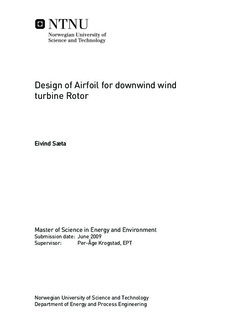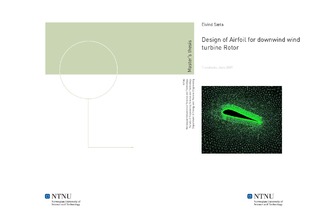| dc.description.abstract | This thesis is on the design of an airfoil for a downwind wind turbine rotor with thin flexible wings, for offshore floating conditions. It has been suggested that such a system would to be lighter, simpler and allow for the use of more efficient airfoils. There has been a significant amount of work done at NTNU to develop a high-lift airfoil. These are airfoils with very high lift-to-drag ratios. They operate very efficiently at their design angle, but tend to not work well over a range of angles and conditions, and have a sudden and dramatic stall characteristic. In this thesis, it is attempted to pick up the work done with the high-lift profiles at NTNU in the 1980 s, and develop a new profile which has performance in the high-lift range, but with a much smoother stall and more stable characteristics, and to do so for the typical conditions expected for the suggested turbine. A fictitious 5 MW version of the suggested turbine was created and analyzed with the blade element momentum method (BEM). This gave informative results about the conditions the new airfoil must operate in. The high-lift technology and the earlier reports from NTNU were studied. Based on this knowledge and the numerical values from the BEM calculations, a serious of new airfoils were developed. By using the simulation programs Xfoil and Fluent (CFD), it was possible to modify and test a large number of airfoils and find the desired qualities.It was possible to design airfoils that had performance in the high-lift range, while maintaining stable operation and having a soft stall, and also increase the lift coefficient to be able to design for lower angles of attack. The profiles created here appear to be suitable for wind turbines, and provide an impressive increase in performance compared to traditional airfoils.Extra effort was put into making airfoils that were unaffected by roughness, air properties and Reynolds number, as stable performance in varying conditions are necessary for wind turbine blades. This was done by using adverse pressure gradients to control the point of transition.A slow stall was achieved by letting the pressure recovery distribution gradually approach the local ideal Stratford distribution when moving back over the airfoil. This caused the flow separate at the back first, and then the separation would grow gradually forward with increasing angle of attack.The inclusion of a separation ramp also worked very well together with the high-lift design, and allowed for an increased lift coefficient and more stable operation during the region of early stall.The most successful profile created appears to be the AR profile. It combines a diverged Stratford distribution with a separation ramp and a pressure spike at the nose to control transition. It has a wider range, stalls later and softer, and has a much more stable performance with varying conditions compared to the original HOG profile from NTNU. At the design point, the maximum performance is reduced only 5.9 % compared to the HOG. For higher and lower angles of attack, and increased values of roughness and turbulence, the AR has an all round higher performance than the HOG. It appears to be usable for wind turbines, and would increase the maximum airfoil performance by up to 40 % compared to commonly used NACA profiles. More good profiles were made, with varying thickness, stall and performance. Depending on the exact local requirements of an application, this report offers several interesting profiles to choose from. For instance, the D2 profile has round shape and over 16 % thickness, it has an even softer stall than the conventional wind turbine profiles, and would increase the maximum airfoil performance by up to ~34%. This profile would also be usable for upwind turbines.It was found that there is a big potential for manipulating the high-lift technology to give various shapes and performances. The usability of these profiles therefore appears to be wider than previously assumed. | nb_NO |

